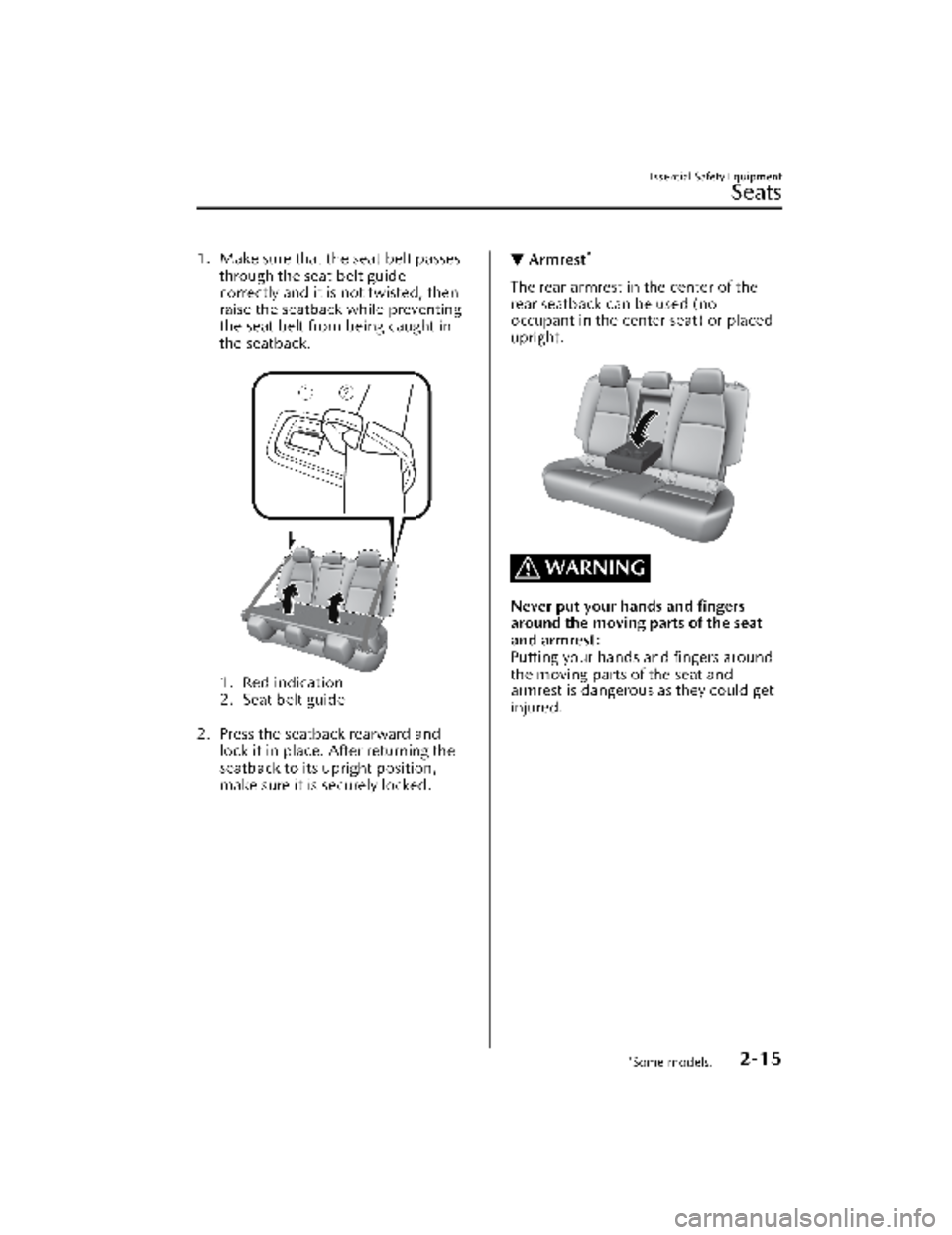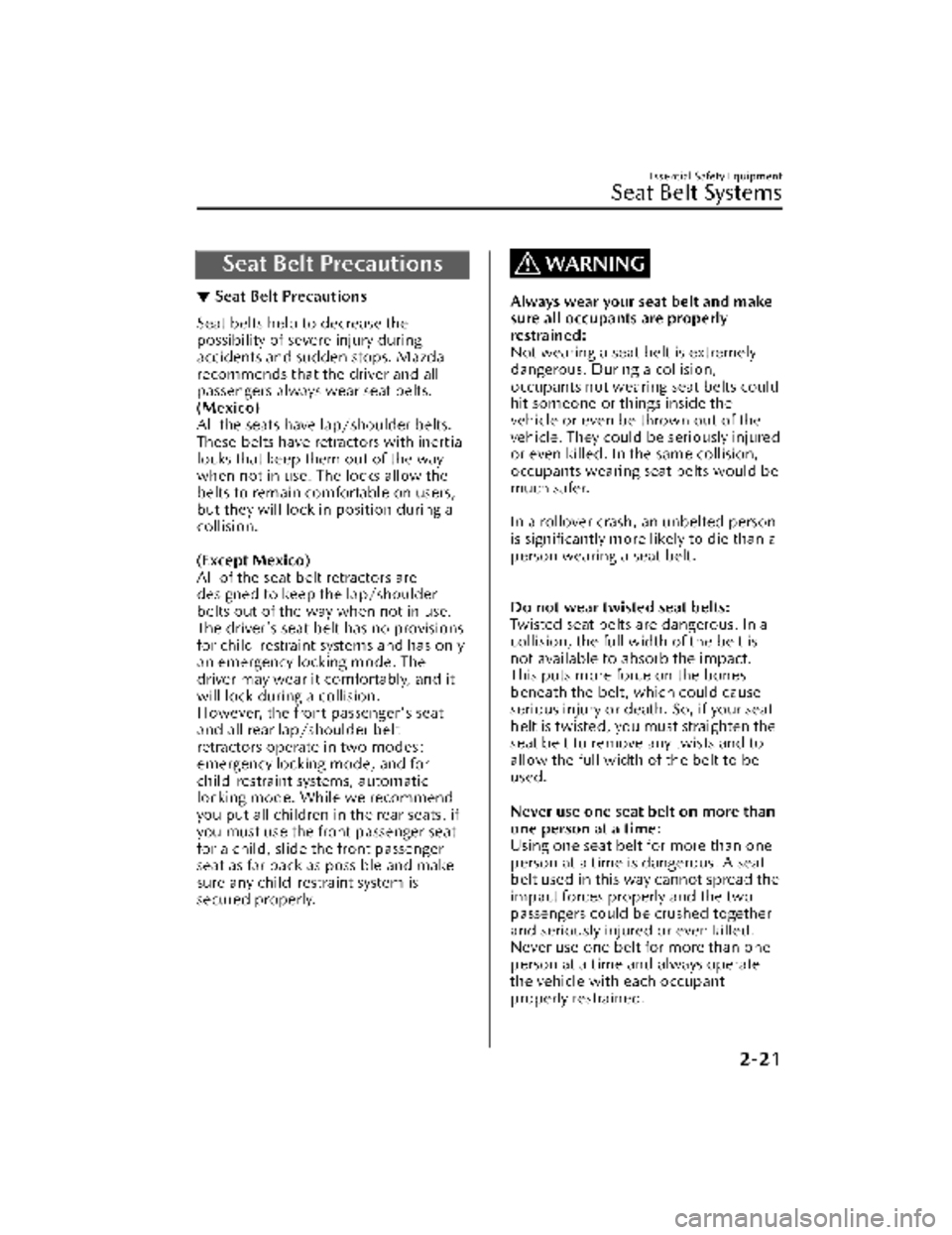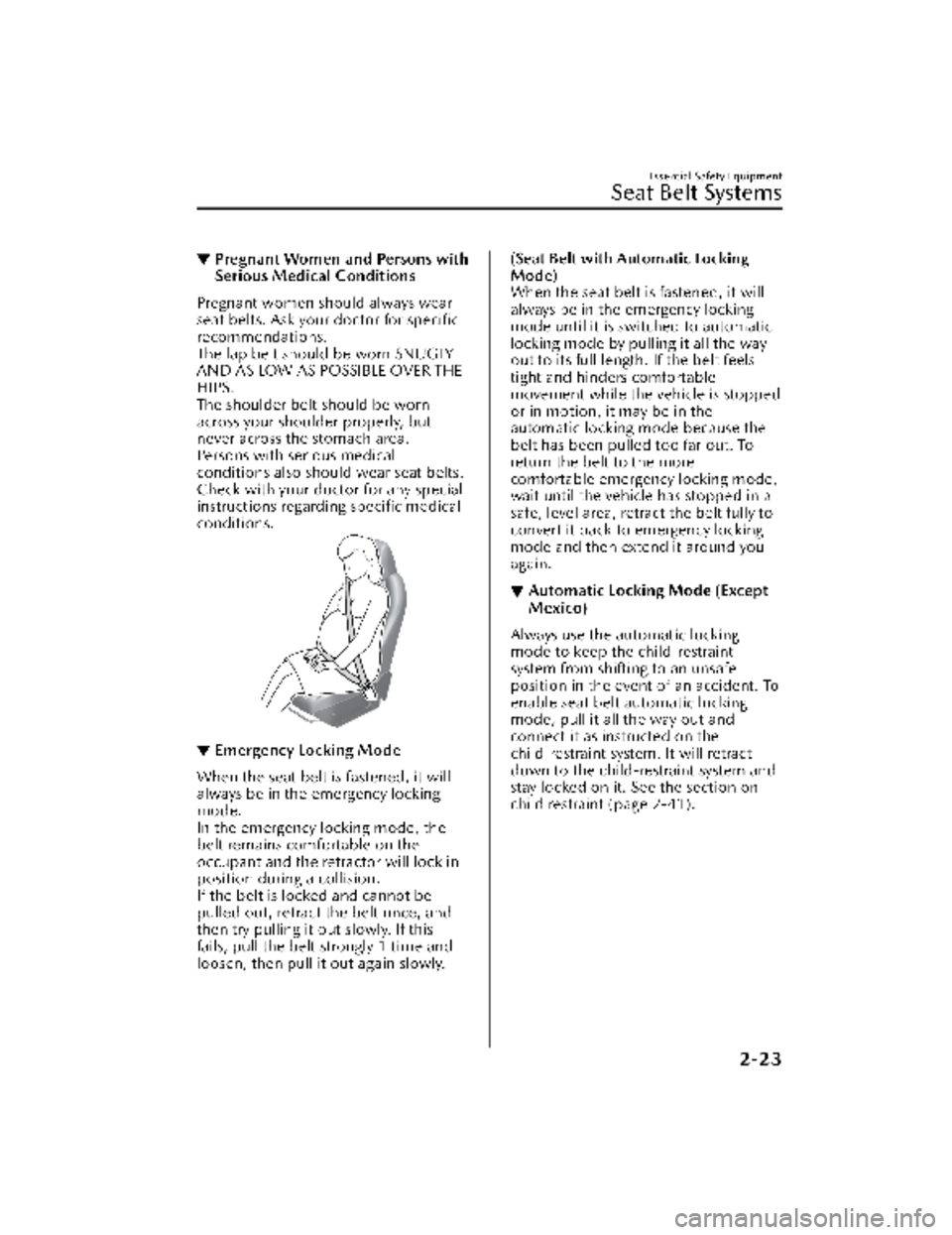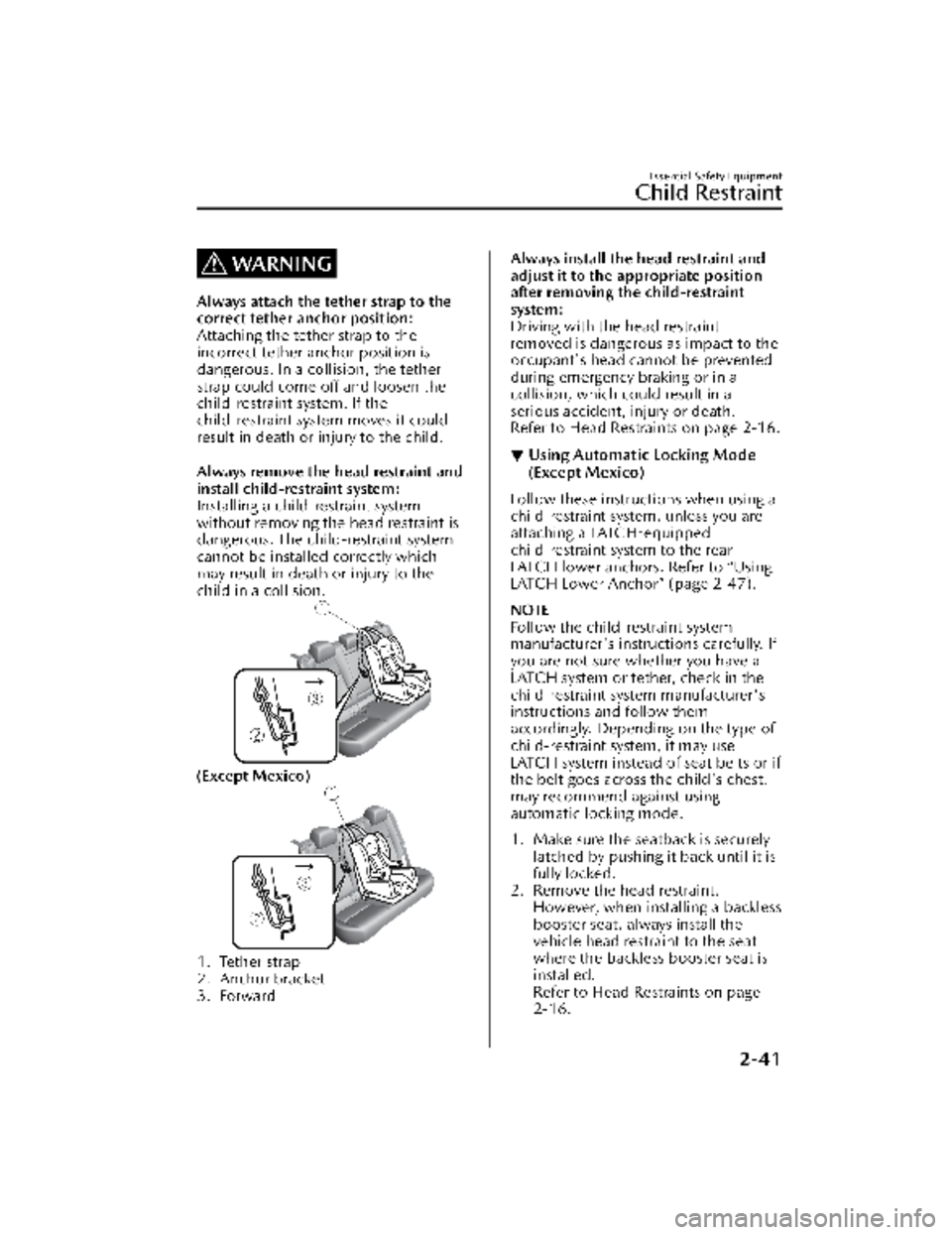back seat MAZDA MODEL CX-30 2022 User Guide
[x] Cancel search | Manufacturer: MAZDA, Model Year: 2022, Model line: MODEL CX-30, Model: MAZDA MODEL CX-30 2022Pages: 595, PDF Size: 84.02 MB
Page 31 of 595

Press the push knob to fold down the
seatback.
To return the seatback to its upright
position:
WARNING
When returning a seatback to its
upright position, make sure the
3-point seat belt is not caught in the
seatback and the 3-point seat belt is
not twisted.
If the seat belt is used while it is
twisted and caught in the seatback, the
seat belt cannot function at its full
capacity, which could cause serious
injury or death.
When returning a seatback to its
upright position, make sure that it is
firmly locked and the red indication is
not visible.
If the red indication is visible behind
the push knob, it means the seatback
is not locked. If the vehicle is driven
without the seatback locked, it could
fold down suddenly and cause an
accident.
1. Locked position
2. Unlocked position
3. Red indication
Essential Safety Equipment
Seats
2-14
CX-30_8KN2-EA-21L_Edition1_new2021-9-15 19:39:56
Page 32 of 595

1. Make sure that the seat belt passesthrough the seat belt guide
correctly and it is not twisted, then
raise the seatback while preventing
the seat belt from being caught in
the seatback.
1. Red indication
2. Seat belt guide
2. Press the seatback rearward and lock it in place. After returning the
seatback to its upright position,
make sure it is securely locked.
▼Armrest*
The rear armrest in the center of the
rear seatback can be used (no
occupant in the center seat) or placed
upright.
WARNING
Never put your hands and
fingers
around the moving parts of the seat
and armrest:
Putting your hands and fingers around
the moving parts of the seat and
armrest is dangerous as they could get
injured.
Essential Safety Equipment
Seats
*Some models.2-15
CX-30_8KN2-EA-21L_Edition1_new 2021-9-15 19:39:56
Page 38 of 595

Seat Belt Precautions
▼Seat Belt Precautions
Seat belts help to decrease the
possibility of severe injury during
accidents and sudden stops. Mazda
recommends that the driver and all
passengers always wear seat belts.
(Mexico)
All the seats have lap/shoulder belts.
These belts have retractors with inertia
locks that keep them out of the way
when not in use. The locks allow the
belts to remain comfortable on users,
but they will lock in position during a
collision.
(Except Mexico)
All of the seat belt retractors are
designed to keep the lap/shoulder
belts out of the way when not in use.
The driver's seat belt has no provisions
for child-restraint systems and has only
an emergency locking mode. The
driver may wear it comfortably, and it
will lock during a collision.
However, the front passenger's seat
and all rear lap/shoulder belt
retractors operate in two modes:
emergency locking mode, and for
child-restraint systems, automatic
locking mode. While we recommend
you put all children in the rear seats, if
you must use the front passenger seat
for a child, slide the front passenger
seat as far back as possible and make
sure any child-restraint system is
secured properly.
WARNING
Always wear your seat belt and make
sure all occupants are properly
restrained:
Not wearing a seat belt is extremely
dangerous. During a collision,
occupants not wearing seat belts could
hit someone or things inside the
vehicle or even be thrown out of the
vehicle. They could be seriously injured
or even killed. In the same collision,
occupants wearing seat belts would be
much safer.
In a rollover crash, an unbelted person
is
significantly more likely to die than a
person wearing a seat belt.
Do not wear twisted seat belts:
Twisted seat belts are dangerous. In a
collision, the full width of the belt is
not available to absorb the impact.
This puts more force on the bones
beneath the belt, which could cause
serious injury or death. So, if your seat
belt is twisted, you must straighten the
seat belt to remove any twists and to
allow the full width of the belt to be
used.
Never use one seat belt on more than
one person at a time:
Using one seat belt for more than one
person at a time is dangerous. A seat
belt used in this way cannot spread the
impact forces properly and the two
passengers could be crushed together
and seriously injured or even killed.
Never use one belt for more than one
person at a time and always operate
the vehicle with each occupant
properly restrained.
Essential Safety Equipment
Seat Belt Systems
2-21
CX-30_8KN2-EA-21L_Edition1_new 2021-9-15 19:39:56
Page 40 of 595

▼Pregnant Women and Persons with
Serious Medical Conditions
Pregnant women should always wear
seat belts. Ask your doctor for
specific
recommendations.
The lap belt should be worn SNUGLY
AND AS LOW AS POSSIBLE OVER THE
HIPS.
The shoulder belt should be worn
across your shoulder properly, but
never across the stomach area.
Persons with serious medical
conditions also should wear seat belts.
Check with your doctor for any special
instructions regarding specific medical
conditions.
▼ Emergency Locking Mode
When the seat belt is fastened, it will
always be in the emergency locking
mode.
In the emergency locking mode, the
belt remains comfortable on the
occupant and the retractor will lock in
position during a collision.
If the belt is locked and cannot be
pulled out, retract the belt once, and
then try pulling it out slowly. If this
fails, pull the belt strongly 1 time and
loosen, then pull it out again slowly.
(Seat Belt with Automatic Locking
Mode)
When the seat belt is fastened, it will
always be in the emergency locking
mode until it is switched to automatic
locking mode by pulling it all the way
out to its full length. If the belt feels
tight and hinders comfortable
movement while the vehicle is stopped
or in motion, it may be in the
automatic locking mode because the
belt has been pulled too far out. To
return the belt to the more
comfortable emergency locking mode,
wait until the vehicle has stopped in a
safe, level area, retract the belt fully to
convert it back to emergency locking
mode and then extend it around you
again.
▼Automatic Locking Mode (Except
Mexico)
Always use the automatic locking
mode to keep the child-restraint
system from shifting to an unsafe
position in the event of an accident. To
enable seat belt automatic locking
mode, pull it all the way out and
connect it as instructed on the
child-restraint system. It will retract
down to the child-restraint system and
stay locked on it. See the section on
child restraint (page 2-41).
Essential Safety Equipment
Seat Belt Systems
2-23
CX-30_8KN2-EA-21L_Edition1_new
2021-9-15 19:39:56
Page 48 of 595

WARNING
Use the correct size child-restraint
system:
For effective protection in vehicle
accidents and sudden stops, a child
must be properly restrained using a
seat belt or child-restraint system
depending on age and size. If not, the
child could be seriously injured or even
killed in an accident.
Follow the manufacturer's
instructions and always keep the
child-restraint system buckled down:
An unsecured child-restraint system is
dangerous. In a sudden stop or a
collision it could move causing serious
injury or death to the child or other
occupants. Make sure any
child-restraint system is properly
secured in place according to the
child-restraint system manufacturer's
instructions. When not in use, remove
it from the vehicle or fasten it with a
seat belt, or attach it to BOTH ISOFIX/
LATCH
*1 lower anchors for ISOFIX/
LATCH*1 child-restraint systems and
the corresponding tether anchor.
*1 ISOFIX (Mexico)/LATCH (Except Mexico)
Always secure a child in a proper
child-restraint system:
Holding a child in your arms while the
vehicle is moving is extremely
dangerous. No matter how strong the
person may be, he or she cannot hold
onto a child in a sudden stop or
collision and it could result in serious
injury or death to the child or other
occupants. Even in a moderate
accident, the child may be exposed to
air bag forces that could result in
serious injury or death to the child, or
the child may be slammed into an
adult, causing injury to both child and
adult.
Never use a rear-facing child-restraint
system in the front seat with an air
bag that could deploy:
Rear-facing child-restraint systems on
the front seat are particularly
dangerous even though you may feel
assured that a front passenger air bag
will not deploy based on the fact that
the front passenger air bag
deactivation indicator light illuminates.
The child-restraint system can be hit by
a deploying air bag and moved
violently backward resulting in serious
injury or death to the child.
Essential Safety Equipment
Child Restraint
2-31
CX-30_8KN2-EA-21L_Edition1_new 2021-9-15 19:39:56
Page 49 of 595

(Mexico)
NEVER use a rearward facing child
restraint on a seat protected by an
ACTIVE AIRBAG in front of it, DEATH
or SERIOUS INJURY to the CHILD can
occur.
Vehicles with a front passenger air bag
have the following warning label. The
warning label reminds you not to put a
rear-facing child-restraint system on
the front passenger seat at any time.
(Except Mexico)
Vehicles with a front passenger air bag
have the following warning label. The
warning label reminds you not to put a
rear-facing child-restraint system on
the front passenger seat at any time.
Do not install a front-facing
child-restraint system on the front
passenger seat unless it is
unavoidable:
In a collision, the force of a deploying
air bag could cause serious injury or
death to the child. If installing a
front-facing child-restraint system on
the front passenger seat is
unavoidable, move the front passenger
seat as far back as possible.
Seating a child in a child-restraint
system on the front passenger seat is
dangerous under certain conditions
(With Front Passenger Occupant
Classification System):
Your vehicle is equipped with front
passenger seat weight sensors. Even
with the front passenger seat weight
sensors, if you must use the front
passenger seat to seat a child, using a
child-restraint system on the front
passenger seat under the following
conditions increases the danger of the
front passenger air bag deploying and
could result in serious injury or death
to the child.
The front passenger air bag
deactivation indicator light does not
illuminate when seating a child in the
child-restraint system.
Luggage or other items are placed on
the seat with the child in the
child-restraint system.
Essential Safety Equipment
Child Restraint
2-32
CX-30_8KN2-EA-21L_Edition1_new 2021-9-15 19:39:56
Page 50 of 595

A rear passenger or luggage pushing
or pulling down on the front
passenger seatback.
Luggage or other items are placed on
the seatback or hung on the head
restraint.
The seat is washed.
Liquids are spilled on the seat.
The front passenger seat is moved
backward, pushing into luggage or
other items placed behind it.
The front passenger seatback
contacts the rear seat.
Luggage or other items are placed
between the front passenger seat
and driver seat.
An electric device is put on the front
passenger's seat.
An additional electrical device, such
as a seat warmer is installed to the
surface of the front passenger seat.
Any accessories, which might
increase the total seated weight on
the front passenger seat, are
attached to the front passenger seat.
The designated positions with seat
belts on the rear seats are the safest
places for children. Always use seat
belts and child restraints.Do not allow a child or anyone to
lean over to or against the side
window of a vehicle with side and
curtain air bags:
It is dangerous to allow anyone to lean
over to or against the side window, the
area of the front passenger seat, the
front and rear window pillars and the
roof edge along both sides from which
the side and curtain air bags deploy,
even if a child-restraint system is used.
The impact of inflation from a side or
curtain air bag could cause serious
injury or death to an out of position
child. Furthermore, leaning over to or
against the door could block the side
and curtain air bags and eliminate the
advantages of supplemental
protection. Because the front seats are
equipped with fron t air bags, the rear
seat is always a better location for
children. Take special care not to allow
a child to lean over to or against the
side window, even if the child is seated
in a child-restraint system.
Never use one seat belt on more than
one person at a time:
Using one seat belt for more than one
person at a time is dangerous. A seat
belt used in this way cannot spread the
impact forces properly and the two
passengers could be crushed together
and seriously injured or even killed.
Never use one belt for more than one
person at a time and always operate
the vehicle with each occupant
properly restrained.
Essential Safety Equipment
Child Restraint
2-33
CX-30_8KN2-EA-21L_Edition1_new 2021-9-15 19:39:56
Page 53 of 595

Due to variations in the design of
child-restraint systems, vehicle seats
and seat belts, all child-restraint
systems may not fit all seating
positions. Before purchasing a
child-restraint system, it should be
tested in the specific vehicle seating
position (or positions) where it is
intended to be used. If a previously
purchased child-restraint system
does not fit, you may need to
purchase a different one that will.
Infant seat
An infant seat provides restraint by
bracing the infant's head, neck and
back against the seating surface.
Equal to Group 0 and 0+ of the UN-R
44 and UN-R 129 regulation.
Child seat
A child seat restrains a child's body
using the harness.
Equal to Group 1 of the UN-R 44 and
UN-R 129 regulation.
Booster seat
A booster seat is a child restraint
accessory designed to improve the fit
of the seat belt system around the
child's body.
Equal to Group 2 and 3 of the UN-R
44 and UN-R 129 regulation.
1. Full booster seat
2. Backless booster seat
When using a backless booster seat,
always install the vehicle head restraint
to the seat where the backless booster
seat is installed.
Essential Safety Equipment
Child Restraint
2-36
CX-30_8KN2-EA-21L_Edition1_new 2021-9-15 19:39:56
Page 54 of 595

Child-Restraint System Suitability for Various SeatPo s i t i o n s Ta b l e
▼Child-Restraint System Suitability
for Various Seat Positions Table
(Mexico)
Provided information in the table shows your child-restraint system suitability for
various seating position. For installation suitability of other manufacturer
child-restraint system, carefully consult the manufacturer's instructions which
accompany the child-restraint system.
When installing a child-re straint system, the following points must be observed:
Always remove the head restraint before installing a child-restraint system.
However, when installing a backless booster seat, always install the vehicle head
restraint to the seat where the backless b ooster seat is installed. In addition,
always use a tether strap and attach it securely. Refer to Head Restraints on page
2-16.
When installing a child-restraint system to the front passenger seat, adjust the seat
slide position as far back as possible.
Refer to Adjusting the Front Passenger's Seat on page 2-12.
When it is difficult to install a child-rest raint system to the front passenger seat, or
the seat belt cannot be secured to th e child-restraint system, perform the
following operations to adjust the seat ho lding the child-restraint system so that
the seat belt can be secured completely to it.
Move the seat forward or back.Move the seatback forward or back.When installing a child-restraint system to the rear seat, adjust the front seat
position so that the front seat does not contact the child-restraint system.
Refer to Adjusting the Driver's Seat on page 2-4.
Refer to Adjusting the Front Passenger's Seat on page 2-12.
When installing a child-restraint system equipped with a tether, remove the head
restraint.
Refer to Head Restraints on page 2-16.
An i-Size child-restraint system refers to a child-restraint system which has
acquired i-Size category certification for the
UN-R 129 regulation.
When installing a child-restra int system to the rear seat, refer to the child-restraint
system manufacturer's instructions and the Using ISOFIX Lower Anchor on page
2-47.
Seating position Passenger Rear (Left) Rear (Center) Rear (Right)
Seating position
suitable for univer-
sal belted (Yes/No) Yes (UF) Yes (U) Yes (U) Yes (U)
Essential Safety Equipment
Child Restraint
2-37
CX-30_8KN2-EA-21L_Edition1_new
2021-9-15 19:39:56
Page 58 of 595

WARNING
Always attach the tether strap to the
correct tether anchor position:
Attaching the tether strap to the
incorrect tether anchor position is
dangerous. In a collision, the tether
strap could come off and loosen the
child-restraint system. If the
child-restraint system moves it could
result in death or injury to the child.
Always remove the head restraint and
install child-restraint system:
Installing a child-restraint system
without removing the head restraint is
dangerous. The child-restraint system
cannot be installed correctly which
may result in death or injury to the
child in a collision.
(Except Mexico)
1. Tether strap
2. Anchor bracket
3. Forward
Always install the head restraint and
adjust it to the appropriate position
after removing the child-restraint
system:
Driving with the head restraint
removed is dangerous as impact to the
occupant's head cannot be prevented
during emergency braking or in a
collision, which could result in a
serious accident, injury or death.
Refer to Head Restraints on page 2-16.
▼Using Automatic Locking Mode
(Except Mexico)
Follow these instructions when using a
child-restraint system, unless you are
attaching a LATCH-equipped
child-restraint system to the rear
LATCH lower anchors. Refer to “Using
LATCH Lower Anchor” (page 2-47).
NOTE
Follow the child-restraint system
manufacturer's instructions carefully. If
you are not sure whether you have a
LATCH system or tether, check in the
child-restraint system manufacturer's
instructions and follow them
accordingly. Depending on the type of
child-restraint system, it may use
LATCH system instead of seat belts or if
the belt goes across the child's chest,
may recommend against using
automatic locking mode.
1. Make sure the seatback is securely
latched by pushing it back until it is
fully locked.
2. Remove the head restraint. However, when installing a backless
booster seat, always install the
vehicle head restraint to the seat
where the backless booster seat is
installed.
Refer to Head Restraints on page
2-16.
Essential Safety Equipment
Child Restraint
2-41
CX-30_8KN2-EA-21L_Edition1_new 2021-9-15 19:39:56